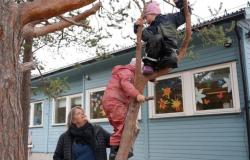DIt has long been a dominant notion that you have to train intensively, preferably in the form of interval training, to get in better shape.
Now new research shows that you absolutely do not need to feel the taste of blood in your mouth to get a good effect from the training.
This goes against previous research, which considered high-intensity exercise to be the most effective form of exercise to improve maximum oxygen uptake, states the University of Agder (UiA).
This triples the chance that the relationship will last a lifetime
“Both intensive training in shorter stretches, and quieter training for a little longer, are effective and give good results for older people if they are carried out systematically and over time,” says research fellow Sindre Herskedal Fosstveit at UiA’s Department of Sports Science and Physical Education.
GOOD NEWS: The research of research fellow Sindre Herskedal Fosstveit shows that it is the total amount of exercise that counts for the elderly – not the intensity. Photo: UiA
view more
He has analyzed 23 different experiments that have been carried out on over 1,300 participants.
view more
It is primarily older people over 60 that Fosstveit has researched. What he found was surprising.
– In the past, we believed that high-intensity training is what gives the best effect if you want to increase your maximum oxygen uptake. But it turns out that the differences between this and training with moderate intensity are smaller than has been assumed.
– There actually does not seem to be any important difference between the two forms of training at all when the total training volume is taken into account, says Fosstveit to KK.
– 16 years are over
– Not to be rude, but won’t high-intensity training stop on its own when we hit 60? How high intensity is it really possible to train with the oars?
– Even if you get older, that doesn’t mean you have to give up high-intensity training. What is considered “high-intensity” can change with age, and depends on your initial physical form, counters the researcher and elaborates:
– For someone over 60, for example, high-intensity training can be brisk walking uphill. So yes, even those over 60 can train at a high intensity, but with activities that are suitable for their starting point and state of health.
Ida-Elviria (28) gets chills and feels sick when she sees this picture
– What about us under 60? Can we also train more calmly than we think we have to?
– Although the main focus of our research has been on the elderly population, other studies have demonstrated that exercise with moderate intensity is effective for both those over and under 60 years of age.
– The importance of regularity often trumps the need for high intensity. This means that even for those under 60, an approach that includes more frequent but less intense training sessions can be a very effective way of improving or maintaining physical fitness and health, reassures Fosstveit.
– I am afraid of being the one who is in the worst shape
A measure of good form
Here, researcher Fosstveit wants to take a short breather to talk about why maximum oxygen uptake is so important – and what is considered moderate and high-intensity exercise.
Seen in isolation, maximum oxygen uptake is only a measure of the body’s maximum ability to absorb and consume oxygen – but is nevertheless connected to our health in several ways.
– It was unusual at the start
A low maximal oxygen uptake is linked to an increased risk of cardiovascular disease and early death.
– As we get older, our physical form deteriorates, and this again shows in the maximum oxygen uptake. But training helps, and can counteract the downward development. Older people can actually achieve the same percentage change as younger people if they exercise, says Fosstveit.
Almost unrecognizable
What exactly is moderate exercise?
But high-intensity training doesn’t stop anyway when you’re over 60, you might be wondering?
No, it doesn’t. Intensity training boils down to the individual’s percentage maximum heart rate.
Moderate intensity training can generally be defined as activities performed with a heart rate that is between 65 and 80 percent of maximum heart rate – that is, you can speak in short sentences if you are running with someone, but it should be challenging to keep a conversation going, explains Fosstveit.
High intensity is when you train with 80 percent of your maximum heart rate or more. Then it should be well done to say a quack at all.
Tags: Research Surprising Exercise Findings
-






